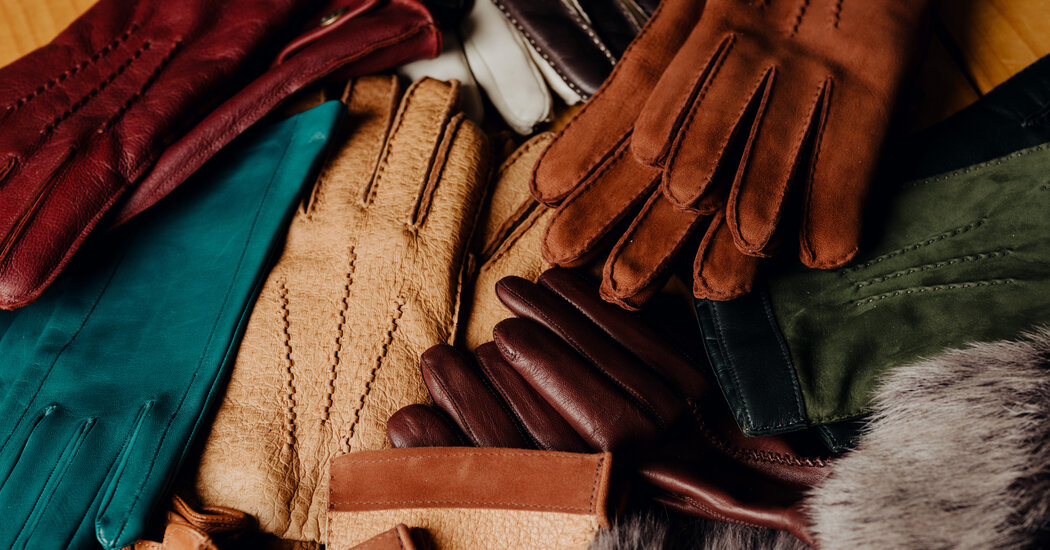
An 80-year-old enterprise still does things the old way but is also looking to the future with new styles and quirky colors.
There is a low buzz of banter and machinery in the workshop of George Horn Ltd., a family-run glove-making business in a converted woolen mill in the Stoneybatter area of central Dublin.
A seamstress bends her head down in concentration over a whirring vintage Singer piqué machine, giving a glove its distinctive but delicate exterior seams. At the next table, another woman hand-sews finger seams while also keeping an attentive eye on a novice practicing lines of raised decorative stitching known as points on the back of a glove. As Christmas approaches and orders stream in, they are at their busiest.
The company — the last glove maker actually manufacturing gloves in Ireland — was established by George Horn in 1943. In its heyday, it employed more than 100 people making gloves for everyday wear and special occasions such as balls, operas, church events and military ceremonies. The gloves were stocked by fashionable brands and department stores, including Christian Dior, Harrods, Saks Fifth Avenue and Bergdorf Goodman.
The founder died in 1981 and now at the helm is his son, Brian, who began his four-year apprenticeship in 1960 at 15.
Today there are five employees working on gloves, and their workshop is not the original — that burned down in 1972, on Brian Horn’s wedding day, he said. Unable to replace their specialized sewing machines for fine leather work (Singer had stopped making them), the Horns turned to making heavy-duty industrial gloves.
But in 2012, the Horns were offered rare equipment from a glove factory in Britain that was closing. Brian and his own son, Gerard, bought the machines and George Horn Ltd. was back in business. As well as running the company as co-owner, Gerard, 49, sews and “points” gloves.
Today, the business creates men’s and women’s gloves from a selection of skins — cow, goat, lamb, boar and deer — in colors with names like Black Shadow, Havana, Midnight Blue and Forest Green. An expanded color palette is planned: Gerard has ordered leathers from Italy dyed quirky pinks, oranges, purples and blues.
Mr. Horn, now 78, cuts all the leather for the company’s gloves, after hand-stretching each piece across a specially made table for up to half an hour, following his own designs and those passed down by his father. He is “probably the last” table cutter working in Ireland, he said: “If there are any left, they’d be in their nineties — or in a museum!”
Most of the trade takes place online and most of the sales come from the United States, with customers determining which size to order by using a hand-measuring guide on the website. People can buy the gloves at the Dublin Leather Store, a shop at the front of the workshop, or have their hands measured there for a made-to-measure fit, recommended for those with especially long or short fingers.
Prices start from 145 euros, or about $155, for a ladies’ glove, depending on the customer’s desired finish — a silk or cashmere lining, for example, or particular detailing, buttons or a lambskin cuff. (Overseas shipping is extra.) The most expensive, at €445, are made from peccary skins, a wild boar hide imported from Peru. These gloves take a full day to sew by hand. “They wear these on Wall Street,” Mr. Horn said. “Hogskin gloves with a cashmere coat. Money isn’t a problem there.”
If he is lucky, Mr. Horn can cut one pair of gloves from each hide because the boar are prone to fighting and “some of the leather comes badly scarred,” he explained as he pointed to scratches in the skin. “Some people will only buy without scars, and others insist on scars because it shows it’s the real thing!”
Mr. Horn’s table catches the light from two windows — good lighting is crucial, he said recently as he worked on a sample for a Dublin seller of men’s accessories. The client had requested a pair of black lambskin gloves trimmed with red and Brian was using aniline leather — pelts dyed to enhance their natural characteristics but sometimes resulting in inconsistent color.
After stretching the hide, he cut the shapes for everything but the thumbs to prepare the gloves for sewing. Gerard Horn then sewed the points, and seamstresses stitched the pieces together, some using machines more than 80 years old. (The most expensive gloves are entirely hand-sewn, Mr. Horn said.)
Two Ukrainians recently joined the company. When the war in Ukraine began, Larysa Ivannikova fled to Poland where she advertised her leather-working skills on a refugee jobs website. The Horns, who wanted to offer a job to a refugee, invited her to come to Ireland and retrain. Hanna Yakovenko, who had moved to Ireland after the war broke out, wrote to the company asking for work and was hired.
Both were new to glove making, although Ms. Ivannikova had specialized in making leather jackets and garments and Ms. Yakovenko had been a shoemaker. Brian said he had marshaled retired seamstresses from the old factory to train the newcomers.
But it’s not all about tradition. The company is introducing new lines designed by Siobhán Curtis, 23, a freelance designer who plans to graduate from the National College of Art and Design next month with a bachelor’s degree in fine arts.
“I’m introducing new styles that will be more modern but using traditional techniques,” she said. “The colors will be vibrant, there will be lots of contrasting colors and a lot of new elements like buckles, lacing and mother-of-pearl beading.”
Starting in the company as an intern, she first needed to learn how to make gloves. “There’s no point designing something if you can’t make it,” Mr. Horn said as he watched her stitch silk linings into gloves, making one tiny stitch on each fingertip to keep the lining from slipping out.
“Brian has been a huge influence, he’s very encouraging, very inspiring,” Ms. Curtis said. “He’s a real master of his trade and there are very few of those left.”
This post was originally published on this site be sure to check out more of their content.








